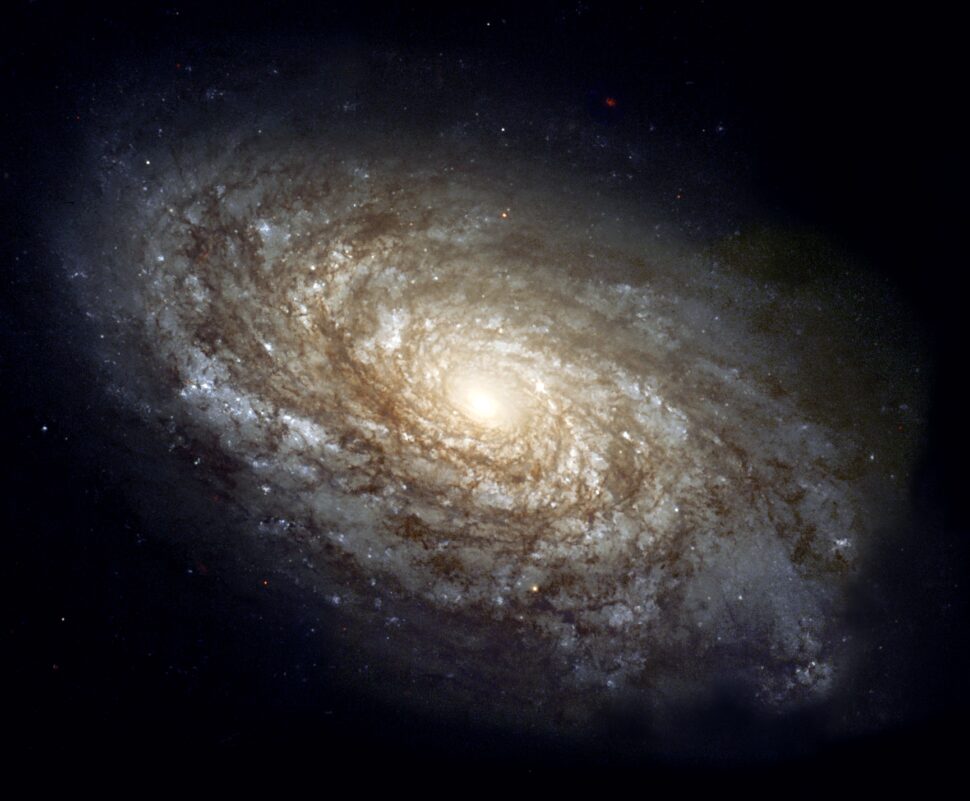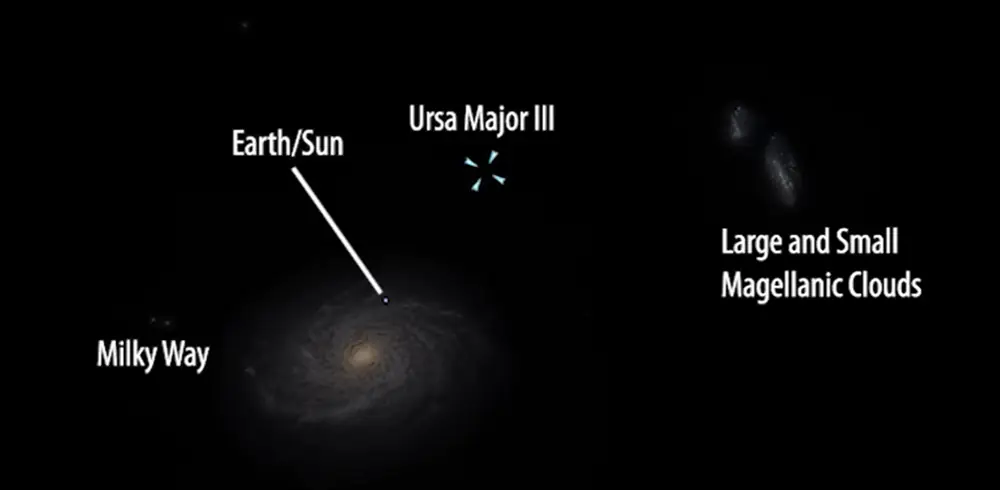
Ursa Major III: The Faintest Milky Way Satellite or a Dark Star Cluster With a Black Hole Core
Ursa Major III is one of the most enigmatic objects near the Milky Way. Discovered in 2023-2024, it lies about 10 kpc from the Sun (just over 30,000 light-years) and has exceptionally low luminosity. This is why debate has intensified around it: is it an ultra-faint dwarf galaxy with a large fraction of dark matter, or a “dark star cluster” in which gravity is dominated by a core of compact remnants black holes and neutron stars?
The object is distinguished by a very small half-light radius roughly 3 ± 1 pc and a meager visible stellar mass. At the same time, dynamical estimates based on the measured velocity dispersion hinted at a mass far above what the light would suggest. In the classic interpretation this reads like a signature of dark matter: the mass-to-light ratio M/Lappears to be hundreds or even thousands of times higher than in ordinary clusters.
That argument is important, but not absolute. M/L can be biased upward by measurement systematics, including the contribution of binary stars, orbital anisotropy, or tidal effects. The central question therefore is: what actually generates the observed dispersion dark matter, or an invisible yet ordinary-in-physics core of compact remnants?
Two Competing Models: Dark Galaxy vs Dark Star Cluster
The first model is an ultra-faint dwarf galaxy. Its case rests on high M/L and stable dispersion, which would indicate a dark matter halo. Without such a halo, a system this compact should quickly be destroyed by the tidal field of the Galaxy.
The second model is a “dark star cluster.” Here the high M/L is explained by mass segregation and a central concentration of black holes and neutron stars, produced as stellar-evolution remnants. Over time, the Milky Way’s tidal forces peel away the outer layers, carrying off lighter stars. What remains is a dense core of heavy but dark components. The result we see is very low light yet substantial dynamical mass without invoking dark matter.

What 2025 Simulations Show: The Role of a Compact Core
Recent N-body simulations reconstruct the evolution of Ursa Major III over billions of years, accounting for its orbit around the Galaxy. The scenario is this: prolonged revolution in the Milky Way’s strong field leads to progressive stripping of the outer layers; with time only a compact remnant remains, in which gravity is dominated by “invisible” stellar remnants black holes and neutron stars while bright stars are few. This naturally explains the high effective mass without dark matter.
Researchers working in this paradigm explicitly describe the object as a “dark star cluster” a system that once looked like an ordinary cluster but has undergone tidal transformation. This approach is also consistent with the fact that the velocity dispersion can be reproduced in a cluster model if one properly accounts for binarity, mass segregation, and the distribution of remnants in the core.
What Remains Contested: Limits of Precision and The Role of Binaries
Even the best models hinge on a critical observational input precise stellar velocities. Two delicate issues matter here:
- Binary stars: a handful of unrecognized binaries can artificially elevate the measured dispersion, mimicking excess mass.
- Tidal geometry: if we observe the system at a moment of enhanced tidal influence, part of the dispersion may stem from a non-equilibrium, perturbed component.
Cautious wording is therefore better than categorical claims. It is more accurate to say “this finding may change our understanding” of the faintest satellites of the Galaxy provided further confirmations arrive.
Post List
Direct Speech: What Authors And Participants In The Debate Emphasize
- “However, final conclusions require additional observations.”
- “The next step will be to search for direct evidence of black holes within Ursa Major III.”
These are not ritual caveats but a real scientific need. Without direct indicators of compact remnants (X-ray, radio, or gravitational effects on neighboring stars), the model remains a hypothesis.
How To Test It: An Observation Program Built For The Question
To distinguish the dark matter model from the dark cluster model, a coherent program is needed:
- Multi-epoch, high-precision spectroscopy of the same stars to filter out binaries and recover a “clean” velocity dispersion.
- Search for electromagnetic signatures of compact remnants: X-ray and radio for low-level accretion or transients pointing to black holes and neutron stars.
- Improved proper motions from upcoming astrometric releases: as reference catalogs refine the motions of the faintest stars, the system’s dynamical portrait will sharpen.
- Deep photometry of the outskirts: look for tidal tails and asymmetries that confirm the stripping scenario.
If even a fraction of ultra-faint satellites turn out to be dark star clusters, we will need to recompute the local dark matter budget and revisit how we classify intermediate systems on the cluster-to-galaxy spectrum. Conversely, if dark matter truly resides in such tiny objects, that widens the nursery for halos and tightens constraints on the nature of dark matter particles.
Careful Optimism And Concrete Next Steps
Ursa Major III is, today, a laboratory at the edge of observational capability. The “dark star cluster” model with a core of black holes and neutron stars offers a convincing way to explain low luminosity together with large dynamical mass without invoking dark matter. At the same time, the velocity dispersion remains sensitive to binaries and tidal disturbances, so categorical verdicts are premature.
The next round must deliver data, not assumptions: multi-epoch velocities, searches for direct markers of black holesand neutron stars, and mapping of tidal structures. Only then will we answer the central question: is this the faintest galaxy of the Milky Way, or a cleverly disguised “dark cluster”?












